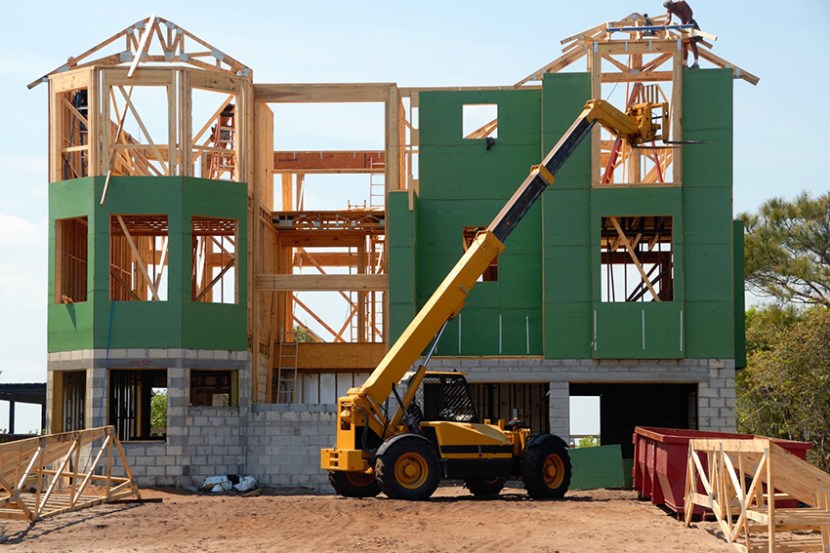
Calm Before the Storm? February Housing Starts Dip 1.5%, Pre-Coronavirus

HUD and the Census Bureau reported privately owned housing starts in February fell slightly to a seasonally adjusted annual rate of 1.599 million—a not discouraging number, analysts said, ahead of the yet-to-be-seen impact of the coronavirus pandemic.
February’s 1.5 percent drop compared to 1.624 million January housing starts figure, but was 39.2 percent higher than a year ago (1.149 million). Single‐family housing starts in February rose to 1.072 million, 6.7 percent higher than the revised January figure of 1.005 million. The February rate for units in buildings with five units or more was 508,000, down by 17 percent from January’s 612,000 but up by 44.3 percent from a year ago.
Regionally, results were erratic. The largest region, the South saw starts jump by 15.2 percent in February to 889,000 units, seasonally annually adjusted, from 772,000 units and January and improve by nearly 37 percent from a year ago. In the Midwest, starts rose by nearly 17 percent to 210,000 units in February from 180,000 in January and improved by 32.1 percent from a year ago.
But that was not enough to offset sharp declines in the West and Northeast. In the West, starts fell by 18.2 percent to 374,000 units, seasonally annually adjusted, in February from 457,000 in January but improved by 49 percent from a year ago. In the Northeast starts wer off by 41.4 percent in February to 126,000 units from 215,000 in January but improved by 41.6 percent from a year ago.
“Housing starts saw another strong month in February, another data point displaying the strength of the housing market before the impacts from the coronavirus,” said Joel Kan, Associate Vice President of Economic and Industry Forecasting with the Mortgage Bankers Association. “Despite a small decline of 1.5 percent, the overall pace of the starts remained in the 1.6 million-unit range for the third straight month, close to the strongest annual pace since 2006. Single-family starts increased slightly and stayed over the 1 million-unit pace, driven by increases in the South and Midwest. The 37 percent year-over-year increase in single-family starts was also notable, the largest since 2012.
Mark Vitner, Senior Economist with Wells Fargo Securities, Charlotte, N.C., said home building could be a source of economic resiliency.
“Most economic data prior to the intensification of the COVID-19 outbreak were showing at least modest growth,” Vitner said. “The housing data, however, have been the strongest of this expansion and were poised to see their best year in more than a decade. That is what the takeaway would have been if so much of the economy was not hunkering down right now. We suspect that single-family homebuilding will show a great deal of resiliency this year but suspect that multifamily construction may slow as apartment operators focus more of their attention on current projects and current operations.”
Vitner noted February’s data, like January’s, was boosted by unseasonably mild weather. “There is little doubt builders will scale back starts somewhat as layoffs mount in coming weeks, but the industry is not likely to pull back as much as it has in prior recessions because activity has been so low for so long in an absolute sense,” he said.
Odeta Kushi, Deputy Chief Economist with First American Financial Corp., Santa Ana, Calif., said yesterday’s results show the impact from the coronavirus pandemic have yet to be seen.
“February’s housing starts numbers, a leading indicator of future completions and net new supply to the housing market, are positive on a year-over-year basis,” Kushi said. “But, those numbers are in our rearview mirror, and the extent to which the coronavirus pandemic affects consumer confidence and future home building reports remains to be seen.”
Kushi said the housing starts report, combined with this week’s dip in the National Association of Home Builders/Wells Fargo Housing Market Index, “is beginning to indicate early signs of coronavirus-driven headwinds to the construction industry, particularly concerns around supply-side disruptions and future demand. “Yet, the fundamentals which drive new home sales remain–near record low mortgage rates, a limited supply of existing homes for sale, and sturdy demand driven by millennials–a generation that is aging into the key lifestyle decisions which drive homeownership demand,” she said.
Building Permits
HUD/Census reported privately owned housing units authorized by building permits in February fell to a seasonally adjusted annual rate of 1.464 million, 5.5 percent below the revised January rate of 1.550 million but 13.8 percent higher than a year ago (1.287 million). Single‐family authorizations in February came in at .1004 million, 1.7 percent higher than January’s revised 987,000. Authorizations of units in buildings with five units or more were 415,000 in February, down by 20.2 percent from January and down by 5 percent from a year ago.
Housing Completions
The report said privately owned housing completions in February fell to a seasonally adjusted annual rate of 1.316 million, 0.2 percent below the revised January estimate of 1.319 million and 1.2 percent below the February 2019 rate of 1.332 million. Single‐family housing completions in February rose to 1.027 million, 14.1 percent above the revised January rate of 900,000. The February rate for units in buildings with five units or more fell to 280,000, down by 31.4 percent from January and down by 41.2 percent from a year ago.
“Due to the slowdown in economic growth and the volatility in markets from the coronavirus, mortgage rates will remain lower for longer, which will help homebuyers in the longer run,” Kan said. “However, we may start to see these homebuilding trends take a turn for the worse, depending on the industry’s ability to continue day-to-day operations during these difficult times.”
